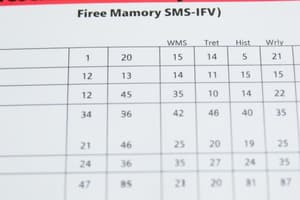Podcast
Questions and Answers
What was the primary intention behind reducing the number of multiple-choice questions to seventeen?
What was the primary intention behind reducing the number of multiple-choice questions to seventeen?
- To reduce the time required to complete the assessment.
- To reduce floor or ceiling effects in quiz scores. (correct)
- To increase the difficulty of the assessment.
- To focus only on aspects of the lecture with the most significant content.
What was the purpose of the writing prompt given to participants?
What was the purpose of the writing prompt given to participants?
- To evaluate their understanding of specific lecture content.
- To get their opinion on course content.
- To assess their academic performance and encourage continuous writing. (correct)
- To determine their level of distraction during academic tasks.
What type of scale was used in the experimenter-created distraction rating form?
What type of scale was used in the experimenter-created distraction rating form?
- A 10-point scale ranging from 'not at all distracted' to 'extremely distracted'.
- A 5-point scale ranging from 'not at all distracted' to 'extremely distracted'. (correct)
- A 3-point scale to assess distraction in lecture, writing and overall.
- A 7-point scale assessing various elements of distraction.
Besides questions regarding distraction, what other information did the distraction rating form seek to obtain?
Besides questions regarding distraction, what other information did the distraction rating form seek to obtain?
What parameters were documented using the observation form?
What parameters were documented using the observation form?
Why did the researcher include multiple choice questions in the assessment?
Why did the researcher include multiple choice questions in the assessment?
What was the range of possible scores for the multiple choice assessment?
What was the range of possible scores for the multiple choice assessment?
What specific writing prompt was given to the study participants?
What specific writing prompt was given to the study participants?
How many questions specifically addressed the lecture task in the distraction rating form?
How many questions specifically addressed the lecture task in the distraction rating form?
What was the range of the 5-point scale used to assess familiarity with lecture content?
What was the range of the 5-point scale used to assess familiarity with lecture content?
What types of data did the observation form capture about participants’ behavior?
What types of data did the observation form capture about participants’ behavior?
Why was it important to determine a baseline level of distractibility for each participant?
Why was it important to determine a baseline level of distractibility for each participant?
In which appendix would one find an example of the multiple-choice question assessment?
In which appendix would one find an example of the multiple-choice question assessment?
What specific aspect of the distractibility was the observer supposed to note?
What specific aspect of the distractibility was the observer supposed to note?
What other data, besides the frequency of behavior, was to be recorded?
What other data, besides the frequency of behavior, was to be recorded?
What was the writing prompt designed to encourage in participants?
What was the writing prompt designed to encourage in participants?
Which academic tasks were analyzed in reference to participant distractibility?
Which academic tasks were analyzed in reference to participant distractibility?
Why was the participants’ level of familiarity with the lecture content questioned in the distraction rating form?
Why was the participants’ level of familiarity with the lecture content questioned in the distraction rating form?
Besides the space for writing which academic task was being analyzed, which of the following information was included in the observation form?
Besides the space for writing which academic task was being analyzed, which of the following information was included in the observation form?
What was the overall goal of the multiple assessments in the study?
What was the overall goal of the multiple assessments in the study?
Flashcards
Purpose of the assessment
Purpose of the assessment
The assessment used to test participants' memory of the lecture.
Assessment Format
Assessment Format
The assessment included 17 multiple-choice questions on various elements of the lecture.
Writing Prompt Purpose
Writing Prompt Purpose
The researcher created it to assess academic performance; it encouraged continuous writing.
Distraction Rating Form
Distraction Rating Form
Signup and view all the flashcards
Distraction Scale
Distraction Scale
Signup and view all the flashcards
Observation Form
Observation Form
Signup and view all the flashcards
Editing the quiz
Editing the quiz
Signup and view all the flashcards
Study Notes
- The number of questions was reduced to 17 to reduce floor or ceiling effects in quiz scores.
- The assessment tested participants' memory of the lecture with reference to Appendix D.
- The assessment included 17 multiple-choice questions on lecture elements, such as "What has a significant impact on gene expression according to the text?"
- The total number of correct responses was documented for analysis, with potential scores from 0 to 17.
- A writing prompt was created to assess academic performance
- The prompt was part of the writing task to encourage continuous writing, it stated, "Describe the purpose of education."
- An experimenter-created distraction rating form was used after academic tasks to determine the participant's distraction level during the study.
- The distraction rating form included three questions: one for the lecture task, one for the writing prompt task, and one for overall distraction.
- Each question used a 5-point response scale, ranging from 1 (not at all distracted) to 5 (extremely distracted).
- The distraction rating form included a question about familiarity with lecture content, answered using a 5-point scale from 1 (not at all familiar) to 5 (extremely familiar), to determine memory assessment validity, see Appendix E for details.
- An observation form was used by an observer to document the frequency and duration of participants' observed distractibility during academic tasks.
- The observation form included space to write which academic task was analyzed, the start and end time of each behavior occurrence, the duration, additional comments, total duration, and space to log behavior frequency, see Appendix F for a copy.
Studying That Suits You
Use AI to generate personalized quizzes and flashcards to suit your learning preferences.





